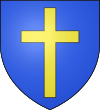Saint Ouen, Jersey
| Saint Ouën | ||
|---|---|---|
| Jersey parish | ||

Cliffs at Plémont
|
||
|
||
 Location of Saint Ouën in Jersey |
||
| Crown Dependency | Jersey, Channel Islands | |
| Government | ||
| • Connétable | Michael Paddock | |
| Area | ||
| • Total | 15 km2 (6 sq mi) | |
| Area rank | Ranked 1st | |
| Population (2011) | ||
| • Total | 4,097 | |
| • Density | 270/km2 (710/sq mi) | |
| Time zone | GMT | |
| • Summer (DST) | UTC+01 (UTC) | |
| Postcode district | JE3 | |
| Postcode sector | 2 | |
Saint Ouen (Jèrriais: Saint Ouën) is one of the twelve parishes of Jersey in the Channel Islands. It is in the north west of Jersey. The parish is the largest parish by surface area, covering 8,341 vergées (15 km²).
It is reputed to be the most traditional of the parishes, being the farthest from Saint Helier and with much of the territory of the parish forming a peninsula. Its manor, Saint Ouen's Manor, the seat of the de Carteret family for over eight centuries - is the senior fief in the island, and the influence of that family has also been a factor in the parish's independent-minded approach to its affairs.
A number of the most influential writers of Jersey have been St. Ouennais. George F. Le Feuvre (1891–1984), who wrote under the pseudonym "George d'la Forge", was one of the most prolific authors of Jèrriais literature of the 20th century. Frank Le Maistre (1910–2002), compiler of the Dictionnaire Jersiais-Français (1966), did much to standardise the St. Ouennais dialect of Jèrriais as a literary language. Edward Le Brocq (1877–1964) wrote a weekly newspaper column from 1946 to 1964 recounting the lives and opinions of two St. Ouennais characters, Ph'lip and Merrienne.
The traditional nickname for St. Ouennais is Gris Ventres (grey bellies) - a reference to the custom of men from the parish to wear jerseys of undyed wool, which distinguished them from men from other parishes who generally wore blue.
A number of prehistoric sites are located in St. Ouen, including the dolmen des Monts Grantez, located at Le Chemin des Monts; the dolmen des Geonnais; and the prehistoric site at Le Pinacle, which also contains one of the very few identifiable Gallo-Roman sites to be seen in Jersey, the foundations of a fanum (small temple).
...
Wikipedia

